Garden Glimpses: August Slump
It happens every year, and it’s always a letdown. August. If I could excise it from the calendar, I would. After the floral exuberance of July, August comes as a wet blanket, if anything as drought-inclined as August can be termed “wet” in any sense. Daylilies done, echinacea ended, bee balm bereaved. Rudbeckia straggles on for a few weeks, declining daily, but still providing some pops of brilliant yellow color, until by month’s end it’s just a mass of desiccated brown.
This year August has been pretty amazing, actually, insofar as precipitation is concerned. With regular thunderstorms and a few soaking days, I haven’t had to water the garden since the 3rd, and I confess to being thoroughly spoiled by the experience, to the point of experiencing PTSD flashbacks whenever I pass a watering can. But all that moisture hasn’t translated to a single extra bloom, anywhere. August just sucks.
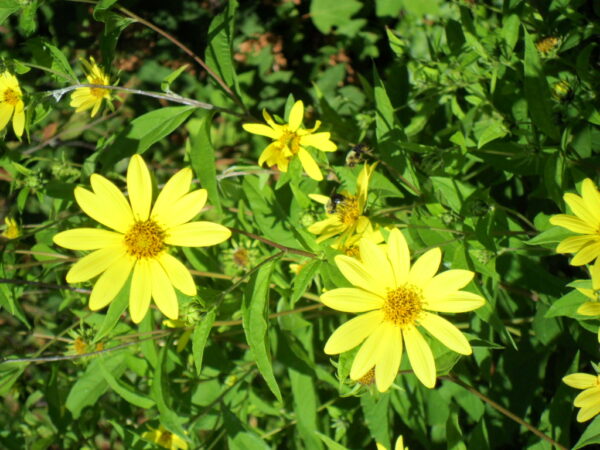
But September is on the horizon, and there were a few bright spots in August that deserve their due before we leave it far behind. Some plants hold their fire until the eighth month, and I am always ready to incorporate these into my master plan of garden color 365 days a year.
Among these are helianthus “Lemon Queen” and vernonia “Iron Butterfly,” AKA ironweed. They make a lovely color wheel contrast, yellow and purple, and both start to come into flower at about the same time, in the last two weeks of August.
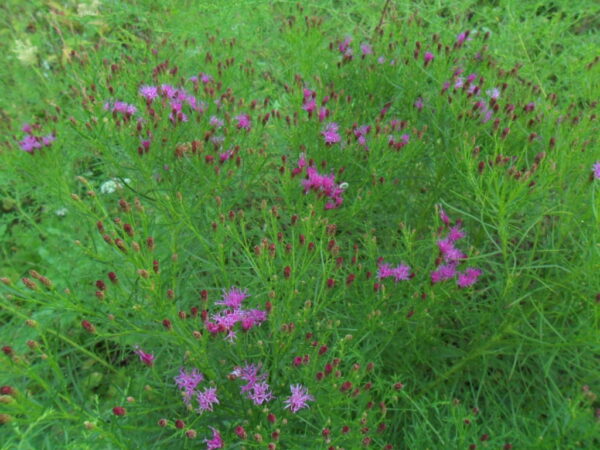
I bought the Lemon Queen (which was mismarked as Maximillian) via mail-order five years ago. It came as a pair of what looked like twigs with a bit of corn silk adhering. I took one look and said, “This is never going to grow,” but I had the landscape team plunk them in anyway.
And how wrong I was! A good four to five feet in height, Lemon Queen dies down to the soil every autumn but comes back with a vengeance in the spring, developing into a thick mass of foliage some five feet in diameter, crowned in late summer with hundreds of pale yellow daisy-like blooms that pollinators go crazy for. At least, most years it does.

If Lemon Queen has a failing, and it does, it’s that it really likes a lot more moisture than my natural conditions here provide. It would wilt daily in dry spells, and need a bucket or two of water to revive. But this year I was impressed by the lack of wilt – “She’s finally adapted to the local conditions,’ I thought. ‘Good for her.’
Well, not so much, actually. She didn’t wilt, but she did suffer from the early drought. With so much going on in the garden, it took me awhile to take note of the dieback on her lower reaches which are a telltale sign of drought stress. I had been watering her in rotation with everything else in her section, about twice weekly, but she was only feigning contentment with that arrangement. By the time I caught on, she was past aid, and though she is surviving, her bloom count is way down this year, the August rain bonanza coming too late for her to set more buds. Sorry, bumblebees! Try the Queen Anne’s lace.

Ironweed is a new fave of mine, with fine ferny foliage topped with intense fuzzy blossoms in purple-red. Ironweed was late to the party this spring, to the extent that I thought I’d lost her, but she came roaring back in late May, almost doubled in size from last year, forming a barrel of bloom some three feet high and about as wide.
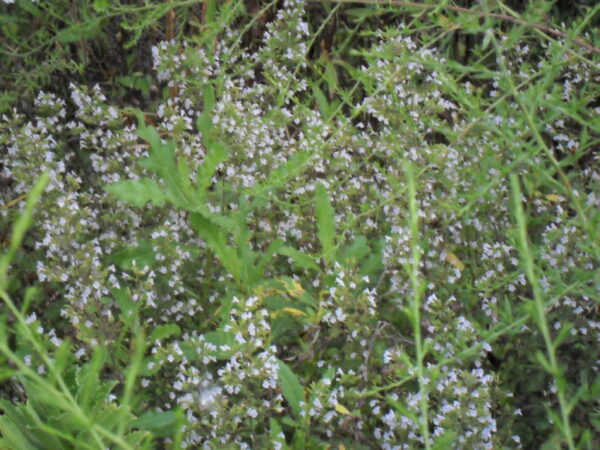
I can’t find enough good things to say about calamintha, AKA calamint, a medium-height, aerial plant peppered with minuscule snow-white blooms for months. Slow to flower, once she gets going, calamint provides continuous bloom from early July to frost, a veritable blizzard-in-miniature that brightens the landscape wherever she’s sited.
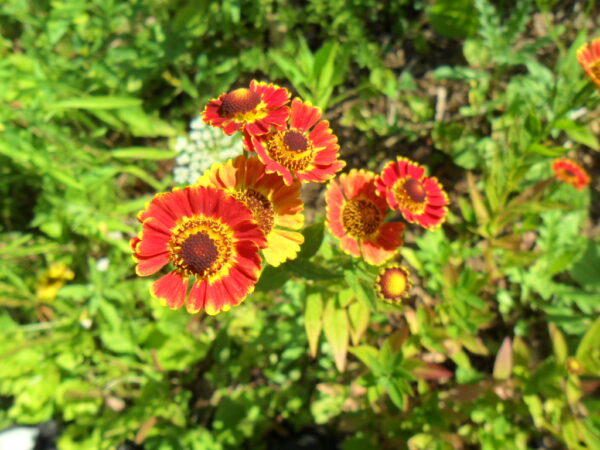
Helenium is another reliable performer, if it’s happy where it is. Sadly, most of mine weren’t, but one variety, “Mardi Gras,” has done very well. In tones from fire to straw, with a large, bulbous, buttonlike brown center, helenium helps to fill the August floral gap from summer to fall.
Of course buddleia, the so-called butterfly bush, is still going strong, and will into mid-autumn. I have two varieties, a bright pink and paler lavender; both benefit from frequent deadheading which alas! I found no time for this year, but they’re managing quite well without the haircuts. The pink version is atop the sandmound and quite vigorous (perhaps too much so for that venue, with roots possibly interfering with the septic system); at four years old, it’s well established, and even a hard cut in mid-winter doesn’t prevent its massive annual growth spurt.
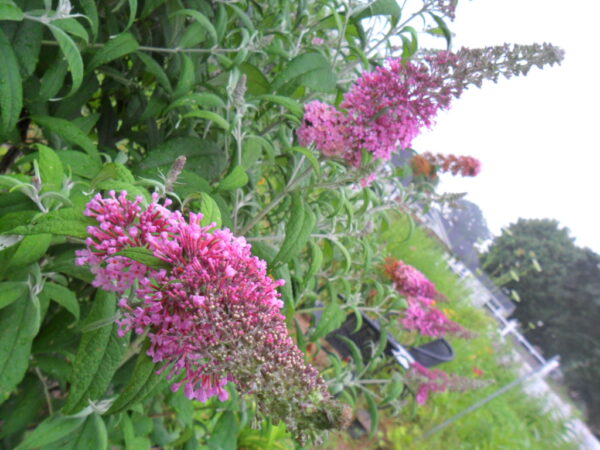
The lavender version was a gift from a friend’s garden, a tiny scion of his plant, which pretty much just sat there for two years, but has really taken off in season three. Now taller than me, it’s still sparing in its growth, but I’m confident that before long, it will be as bushy as its cousin.

While on the topic of things butterfly-related, I’d be remiss not to mention asclepias tuberosa, the butterfly weed. Most of mine are a hybrid variety in yellow, in full flower late June to early July, but I do have one native plant, in vivid orange, at its peak now. It’s smaller over all, but quite stunning without much competition in that color range during August. The post-bloom varieties are something to look at now, too, covered in their strange, unearthly pods that split to reveal masses of fluff which the plant uses to disperse its seeds on the wind. Butterly weed in seed is an apt reminder that not all garden loveliness is contained in the bloom.
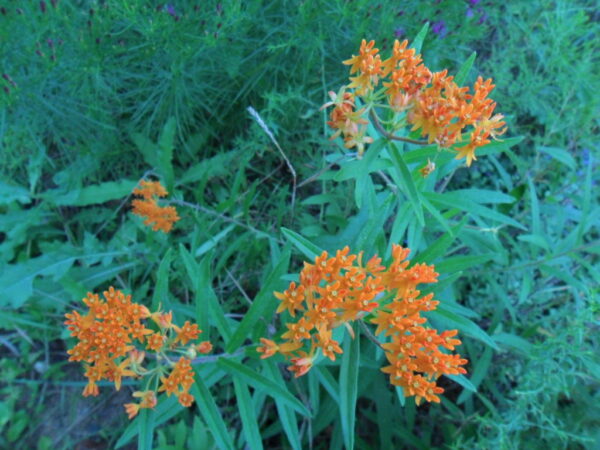

Garlic chives, too, are one of the glories of the August garden. With bladelike leaves that are flatter and broader than their tubular culinary cousins (though they are themselves also edible), garlic chives just look like overgrown grass for most of the summer season. But in early August they start to send up tall spikes tipped with flat, round disks of miniature white, starlike flowers, which make a stunning display en masse.


Garlic chives have been here for decades, a gift from me to my parents in the ‘90s, when they were planted in a small patch under the Chinese dogwood in the front yard. In my father’s time, they weren’t allowed to range far, but they have since spread to fill the small space between the bed proper and the front walk, gradually spanning out to border much of it. More, they have also “jumped” the path, facilitated by dropping seed on the cement walk, which the wind then blows across, to find root on its far side, and now line it there as well, for a lovely double file welcome sign for visitors. The spent flowers develop into attractive seed heads, with small, papery, parchment-colored “bowls” that each envelop a tiny black seed. I allow these to persist beyond the fall, into late winter, for a practical purpose – they stand tall above all but the deepest snowfalls, affording me a precise marker for where the path needs to be shoveled free of covering snow.
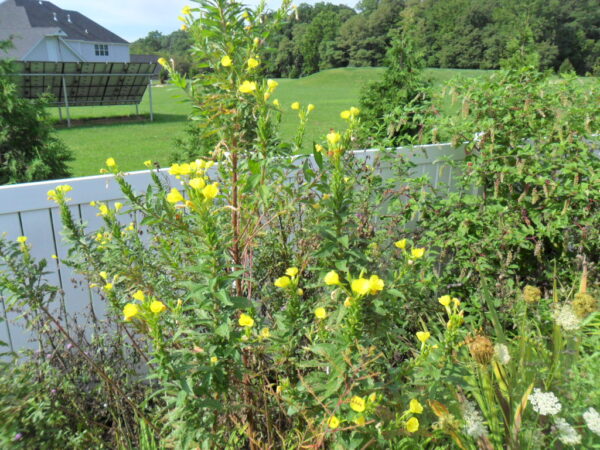
Evening primrose is a native that volunteered for the garden several years ago. A large plant with a branching stem pattern dotted with small, buttercup yellow blossoms, I have known evening primrose to grow to a height of five feet, though this year’s crop is considerably shorter. As the name implies, its flowers open late in the day, and by the time the sun is high the next morning, they are gone. Their primary attraction for me is the long bloom season, running from late June well into September, and the value of their seeds, which are beloved by goldfinches, mourning doves and bobwhites. The former two grace the garden frequently, but it’s been an age since I’ve heard a bobwhite’s trademark song, from which it gets its name, though as a child we often heard them in the fallow field behind the property, now a housing development.
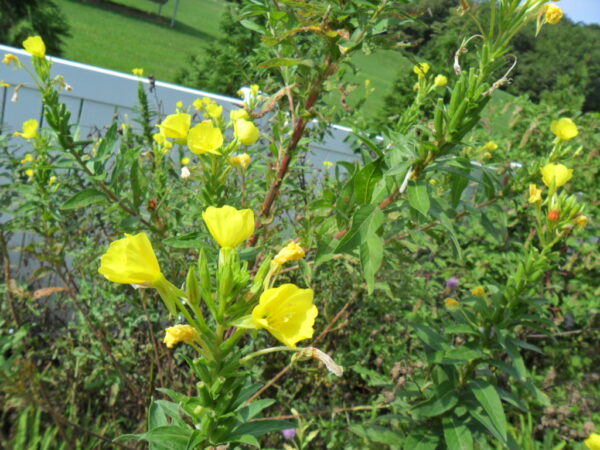
New to the garden this year are two varieties of coreopsis I haven’t tried before. Both are thriving, I’m pleased to report, and doing exceptionally well for first-year mail-order items. Coreopsis as a class are all over the map for bloom times and length of bloom season, and as first-years, these may be flowering out of season, but they started in mid-July and are still going strong! “Berry Chiffon” is my favorite, with a deep maroon-burgundy center tipped in palest pinky white, but “Shade of Rose” is a close contender, with a pink-apricot frill that blushes to pale yellow at the center. I look forward to their expansion year to year, and sited next to the path on the sandmound top, they’re readily accessible for viewing, and eventual cutting for indoor arrangements.
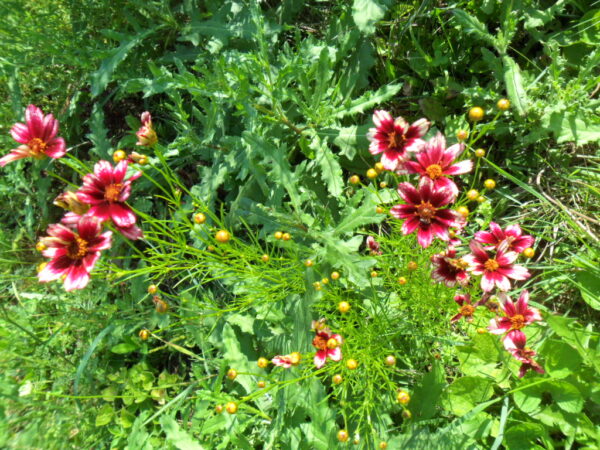

This year I also have a whole new species of plant to enjoy for August – the clematis! My aunt has some lovey clematis varieties that never seem to set “babies,” so my desire to obtain them has been frustrated for years. But a late-season plant sale at Bluestone Perennials (the best mail-order plant company I have found) prompted me to take a risk on four. Clematis are climbers, and like full sun, so finding appropriate conditions in this yard is tricky. I do have an old cement washpost from my parents’ era, which I wrapped in chicken wire to supply more support, and two of these I planted at its base. “Kilian Donahue” was billed as tolerating part shade, which this post gets, so I tried it there, along with an autumn-blooming variety, clematis terniflora.


Kilian appears to be a bust, but the autumn clematis is thriving. We’ve had that plant on the property before, so I knew it would do well here. Autumn clematis dies back to the soil every year, but puts on literally yards of vine growth in a season, heavily covered in clusters of small white flowers. That old, established plant was unceremoniously ripped out to make room for the septic sandmound in 2010, along with half my folks’ cutting garden, and I’m happy to reintroduce it to the yard. I was uncertain what to do with the other two, but I found a workable temporary solution. I had two unused trellises, smallish, maybe four feet in height, and two large unused pots, and a good amount of potting soil. Voila! Instant clematis environment!
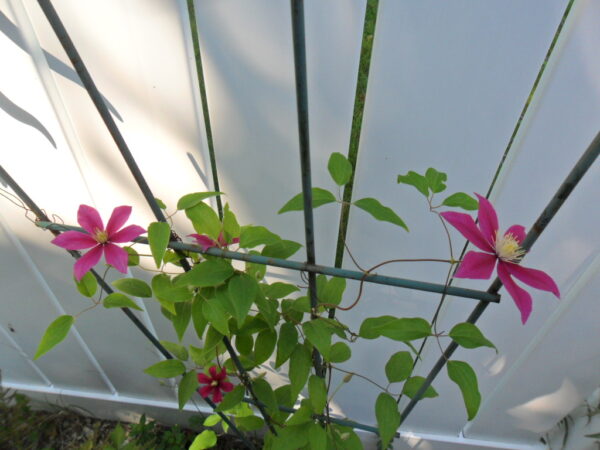

I sited them next to the west fence where they get good light for about half the day, and filtered sun or shade for the rest. The reasoning was that, since they were potted, if they showed signs of being unhappy in that location, I could just pick them up and cart them elsewhere. As well, they’d likely do better in the potting soil than my unforgiving clay.
I couldn’t be more pleased with the result. Clematis “Piilu,” a two-toned lavender-pink with bright fuzzy yellow centers, began flowering in early August, and is bloomed out by now, but clematis “Acropolis,” in vibrant burgundy-red, is right there to pick up the slack! Both have grown to encompass most of their respective trellises, and are easily viewed from the house, another plus for their location.
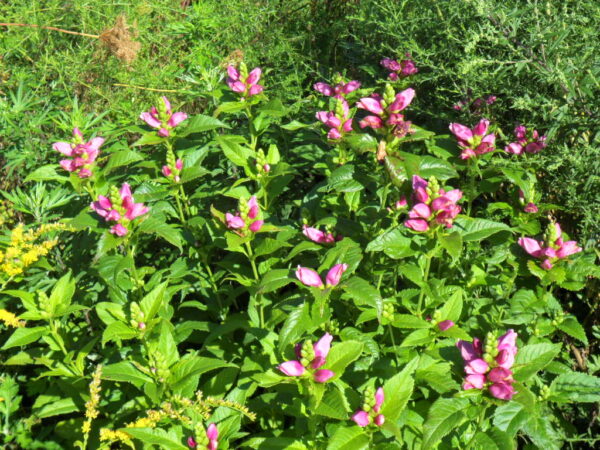

Also as August wanes, the chelone comes into its own. Commonly called turtlehead, this is one of the last plants I purchased at my local perennial farm, before they went belly-up three years ago. It has grown into a huge mass of a plant now, and is useful in the dry months as an “early warning” indicator of drought problems – if chelone is wilting, it’s time to get ahead on the watering! Not a great one for delayed gratification, chelone seems to me to take an agonizingly long time to open the buds it begins to set in late July, but its bloom is perfectly timed to fill the lag in floral output in late August. With elongated clusters of bright pink, almost snapdragon-like blooms, chelone is a lovely addition to that fallow period. Its one disadvantage is that the browned, dead blossoms tend to persist on the stem after fading, which somewhat mars the look of the newly opened ones.
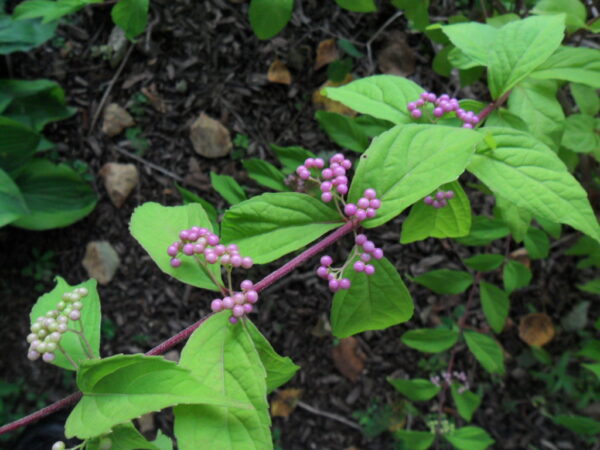
In the final week of August, early intimations of fall commence to appear. Goldenrod is beginning to open its glowing yellow blossoms, native asters are budding up, and some of the woodier perennials are starting to show signs of their transitioning foliage colors. It won’t be long now before roadsides are ablaze with fiery sumac, and farmstands overflow with gourds and pumpkins of every conceivable size, shape and color.

And as September dawns, I heave a huge sigh of relief and say, “It’s about time! Farewell, August – and good riddance!”
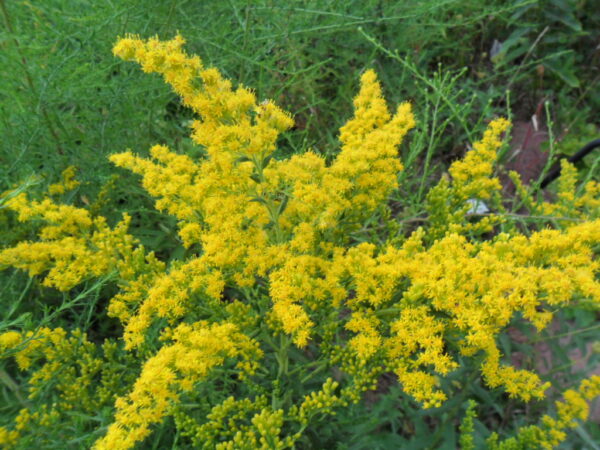


5 comments, add yours.
Charlotte
I really don’t know why you’re complaining Alex! Eveything looks just gorgeous to me.
As always, thank you for sharing.
Alex Miller
Authoryou’re only seeing the good stuff, Charlene, and that’s few and far between! :^)
Dale
A feast for the eyes nevertheless, Alex!
Trish
Gorgeous!
Laurien
Gardeners are always more critical of their gardens than anyone else. Loved your photos especially Helenium, the clematises,
Beautyberry, and goldenrod. Keep up the good work!